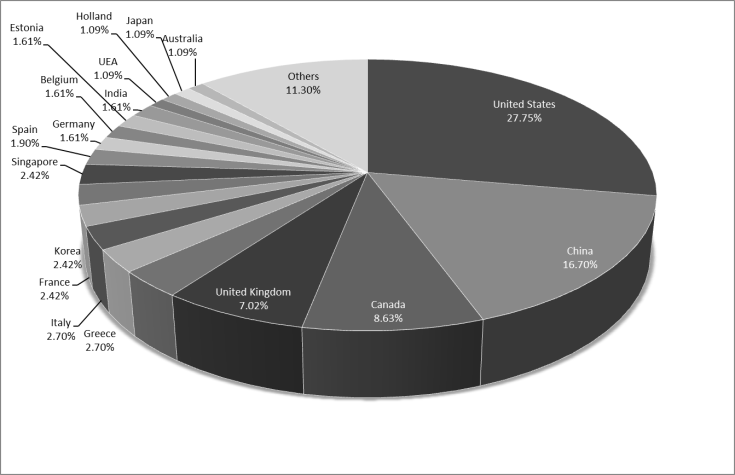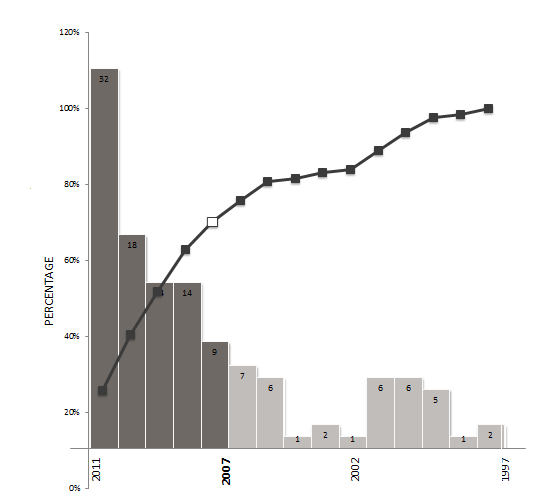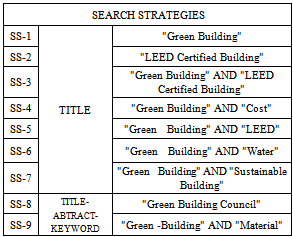-
Paper Information
- Next Paper
- Previous Paper
- Paper Submission
-
Journal Information
- About This Journal
- Editorial Board
- Current Issue
- Archive
- Author Guidelines
- Contact Us
International Journal of Construction Engineering and Management
2012; 1(3): 27-32
doi: 10.5923/j.ijcem.20120103.03
Green Buildings: Analysis of State of Knowledge
Diana Owensby-Conte 1, Víctor Yepes 2
1School of Civil Engineering, Universitat Politècnica de València, Valencia, Spain
2Institute of Concrete Science and Technology (ICITECH), Universitat Politècnica de València, Valencia, Spain
Correspondence to: Víctor Yepes , Institute of Concrete Science and Technology (ICITECH), Universitat Politècnica de València, Valencia, Spain.
| Email: |  |
Copyright © 2012 Scientific & Academic Publishing. All Rights Reserved.
Green building practices emerged to mitigate the effects of the increasing impact on the environment and to improve the building construction process. In this context, a systematic bibliometric analysis is provided. As a result, 124 articles were found in 40 internationally recognized scientific journals related to green buildings. A quantitative analysis is done to the articles in order to know about the authors and countries with most publications; in addition to their evolution from 1980 to 2011. Then a qualitative analysis which aims to obtain the key aspects and obstacles to consider in Green Building and recommendations are given for each aspect. The goal of this paper is to provide building researchers and practitioners a better understanding of how to effectively make decisions to promote energy conservation and sustainability of green buildings.
Keywords: Green Buildings, State of Knowledge, Bibliometric Analysis
Cite this paper: Diana Owensby-Conte , Víctor Yepes , "Green Buildings: Analysis of State of Knowledge", International Journal of Construction Engineering and Management , Vol. 1 No. 3, 2012, pp. 27-32. doi: 10.5923/j.ijcem.20120103.03.
Article Outline
1. Introduction
- Green Building is the practice of improving the building’s efficiency by using energy, water, and materials available on site; with the main goal of reducing the impact on the environment and human health, throughout the whole building life cycle (design, construction, operation, maintenance and demolition)[1]. Improving today’s conventional design, building practices and standards, extending the building life by making it more durable and efficient, and minimizing its operative cost, increasing its productivity, and giving a healthier living and working environments to its occupants[2]. Nowadays, more people are moving to the city causing a significant increase in the construction of buildings and/or skyscrapers, and hence a booming in the city economy but with great repercussions in the environment. This activity urge for a huge demand on material supply[3], this activity is responsible for 30% of all greenhouse gas emissions, 65% of waste output, 70% of electrical consumption and 12% of water consumption[4]. Therefore, it seems crucial to incorporate design criteria to minimize these impacts[5-6].For this reason, Green Buildings is intended to reduce construction costs and building maintenance. Reducing energy costs and environmental impacts of not only the structure but also the site on which it will be placed. Other benefits are an increment of comfort, safety and health of building users, and provide a friendly environment to increase productivity.Accordingly to this concept, the purpose of this study is to analyse the state of knowledge up-to-date. Additionally a qualitative analysis provided a decision making tool for the construction of green buildings. This research was made as a Master Thesis[7].
 | Figure 1. The meaning of Green Building |
2. Research Method
- The study was conducted through a literature research and a subsequent process and analysis of the papers found. The structure of the research follows five phases:1) Preliminary approach and initial tests.2) Bibliometric search and revision of references.3) Quantitative analysis.4) Exploitation and analysis of results.5) Qualitative analysis.Phase 1 was an initial approach to the topic, which allows familiarization with the main concepts related to Green Buildings, identifying keywords, and designing search strategies. A non-meticulous research was done in commonly use search engines such as Google, using keywords like Green Building, LEED, materials, costs, Green Building Council. After reading the literature available on different web sites, a better understanding of the topic was achieved. As a result of this first review, Green Buildings subject is really interesting for many people, organizations, companies, and is growing up in lot of countries.Phase 2 use the search strategy in Table 1 to start the research in Scopus and Science Direct (bibliographic databases online containing published scientific research as abstracts and citations for academic journal articles, book series and handbooks), delimitating the search since 1980 to 2011. These data bases were chosen because they are scientific, international, and related with the topics. By means of a comprehensive review of all articles found (some of them were only abstracts and were not taken into consideration), in this process the result was export to RefWorks to be classified by year, country, database, type of paper (article and handbook), author and nine categories identified as common aspects in the literature. Six of them –sites, water saving, energy efficiency, interior quality, materials, design and innovation – are based on reviewing points used already in well recognized Green Building certification processes as LEED certification. Two of the remaining categories – costs and tendencies – are important aspects that will impact the feasibility of a Green Building project. The “other” category refers to aspects that cannot be placed into the categories mentioned before, but are worthy of mention. In this phase, the papers found were filtered, removing duplicate articles, and eliminating papers which were not strongly related with the topic of the study.
|
3. Results
3.1. Quantitative Analysis
- A total of 218 papers were found and reviewed, 21 of these papers were duplicated and 73 papers were not strongly related with the topic of the study. Therefore 94 papers were eliminated, leaving 124 articles to be used in the study.
3.1.1. Relevant Journals
- To assure the veracity of the research, the Journal Citation Reports (JCR) index was used as a resource to know the impact of these articles in the scientific community. More than a half of the articles (69.4%) were published in journals with Q1 ranking.
3.1.2. Relevant Authors
- The authors with more publications are: Dai, Y.J.; Ma, Q.; Wang, R.Z.; Zhai, X.Q. from Shangai Jiao, with 4 publications each one.
3.1.3. Countries
- The countries with most publications are U.S.A, China and Canada, with 27.7%, 16.7% and 8.6% respectively.
3.1.4. Evolution throughout Time
- The evolution of Green Buildings research from 1980 until 2011 is shown on Figure 3. The first article appeared in 1997. Before 2007, the number of articles was very few and intermittent. After that year, an increase on interest was evident: 70% of the papers were published.
3.1.5. Research Categories
- The most researched categories, based on phase 2 are: Energy Efficiency (25.8%), Tendencies (15.3%), and Design and Innovation (14.5%).
3.2. Qualitative Analysis
3.2.1. Research Approach
- As a result of the first approach (phase 1), LEED was the rating system most mentioned. The country with the highest number of publications is United States with 27.7%. This could be attributed to the fact that LEED Rating System is the rating more internationally recognized, developed by US Green Building Council.
3.2.2. Green Buildings Aspects
- The first step to contribute with the sustainability is the design of the structure. As a prelude to the construction phase, which has a great influence on many other aspects, a good design takes into account: costs, energy efficiency, water saving, materials, etc.
 | Figure 2. Publications by country |
 | Figure 3. Paper published per year and its evolution throughout time |
 | Figure 4. Papers related with Green Buildings aspects |
4. Recommendations
- Use BIM and other tools such as Autodesk Revit, IES Virtual Environment, among others, which allow 3D modelling simulations to see the operation behaviour of buildings, calculation of energy requirements; and some manual controls to prevent errors in the documentation LEED.Implement the use of green roof and building automation to improve water saving, energy efficiency. Furthermore, green roof and building automation can help to improve interior quality, adding user comfort and efficiency.Using of low toxicity finishes, allowing occupants more control over lighting and including ergonomics aspects can contribute with a better indoor quality. Furthermore, it is recommended a POE (Post Occupancy Evaluation).Apply ecological materials as natural stone, native wood, clay brick, linoleum, lime or silica paint, and also double or triple window glazing in façade to reduce cave effect.The legislation as mandatory encourages, promotes and contributes to the green building construction. In other words is the main starter of green buildings.
|
5. Conclusions
- The amount of papers found through the literature search shows that there is a lot of information available about Green Buildings. Every day, more people, groups, associations, governments, countries are interested in joining the "Green Movement", mainly aware of the importance it has on the environment and also helped by the economic benefits that are available and last but not least, the prestige and recognition that this brings.United States is the country with more papers published and this could be attributed to the fact that LEED Rating System is the most internationally recognized certification rating system, developed by US Green Building Council.A building is green when successfully meets all criteria for attaining certification and all green buildings aspects are closely linked. Good design leads to implement energy saving measures which in turn may or may not influence the water savings. To implement these measures is necessary to use materials, devices, green technology and others aspects. The initial cost increment in green building is the most common of barriers.The energy efficiency is the most interest topic to researchers, because involve in a directly or indirectly way others green building aspects (design, materials, water saving, cost). For that reason, a future line research could be energy efficiency with low cost.
ACKNOWLEDGEMENTS
- This work was supported by the Spanish Ministry of Science and Innovation (Research Project BIA2011-23602).
References
| [1] | Office of the Federal Environmental Executive. The Federal Commitment to Green Building: Experiences and Expectations, Available:http://www1.eere.energy.gov/femp/pdfs/fedcommgreenbuild.pdf |
| [2] | Sam Kubba, Green Construction Project Management and Cost Over site, Elsevier, USA, 2010. |
| [3] | Sidney Levy, Construction Process, Planning and Management: Green and Sustainable Buildings, Elsevier, USA, 2010. |
| [4] | Spain Green Building Council Available: http://www.spaingbc.org |
| [5] | Ignacio Paya-Zaforteza, Victor Yepes, Antonio Hospitaler, Fernando Gonzalez-Vidosa, “CO2-optimization of reinforced concrete frames by simulated annealing”, Engineering Structures, vol. 31, no. 7, pp. 1501-1508, 2009. |
| [6] | Victor Yepes, Fernando Gonzalez-Vidosa, Julian Alcala, Pere Villalba, “CO2-Optimization Design of Reinforced Concrete Retaining Walls Based on a VNS-Threshold Acceptance Strategy”, Journal of Computing in Civil Engineering, vol. 26, no. 3, pp. 378-386, 2012. |
| [7] | Diana Owensby-Conte, “Green Buildings: analysis of the evolution, present and future” Minor Thesis, Universitat Politècnica de València, Spain, 2012. |
| [8] | Salman Azhanar, Wade A. Carlton, Darren Olsen, Irtishad Ahmad, “Building Information Modeling for Sustainable Design and LEED® Rating Analysis”, Automation in Construction, vol. 20, no. 2, pp. 217-224, 2011. |
| [9] | Luis Pérez-Lombard, José Ortiz, Christine Pout, “A Review on Buildings Energy Consumption Information”, Energy and Buildings, vol. 40, no. 3. pp. 394-398, 2008. |
| [10] | Ashwin Sabapathy, Santhosh K.V. Ragavan, Mahima Vijendra, Anjana G. Nataraja, “Energy Efficiency Benchmarks and the Performance of LEED Rated Buildings for Information Technology Facilities in Bangalore, India”, Energy and Buildings, vol. 42, no. 11, pp. 2206-2212, 2010. |
| [11] | Cheng-Li Cheng, “Study of the Inter-Relationship between Water use and Energy Conservation for a Building”, Energy and Buildings, vol. 34, no. 3, pp. 261-266, 2002 |
| [12] | Cheng-Li Cheng, “Evaluating Water Conservation Measures for Green Building in Taiwan. Building and Environment”, vol. 38, no. 2, pp. 369-379, 2003. |
| [13] | Junta de Castilla y León. Manual sobre edificios saludables Available:http://www.intersindical.es/boletin/laintersindical_ saludlaboral_02/archivos/edificios_saludables_2parte.pdf |
| [14] | Cemex España. Cemento Sello Verde Available:http://www.cemex.es/ce/ce_pr_cc.html |
| [15] | Mohsen M. Aboulnaga, “Towards Green Buildings: Glass as a Building element—the Use and Misuse in the Gulf Region”, Renewable Energy, vol. 31, no. 5, pp. 631-653, 2006. |
| [16] | Víctor Yepes, “Influencia de la calidad del proyecto y diseño de un hotel en la protección medioambiental”, Forum Calidad, 113/00, pp.28-34, 2000. |
| [17] | Gregory H. Kats, Capital E, The cost and financial benefits of green buildings: a report to California’s sustainable building task force, USA, 2003. |
 Abstract
Abstract Reference
Reference Full-Text PDF
Full-Text PDF Full-Text HTML
Full-Text HTML